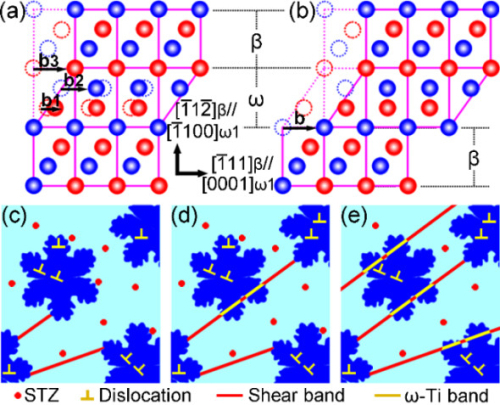Scientists Find New Deformation Mechanism of Bulk Metallic Glass Composites
Bulk metallic glass composites (BMGCs) containing in-situ formed β-Ti dendrites are promising for wide applications because of their large critical casting size, superior mechanical property and good energy-release behavior. However, it remains challenging to effectively tune their microstructures and mechanical properties for application.
Assoc. Prof. ZHANG Long and Prof. ZHANG Haifeng from Institute of Metal Research (IMR), Chinese Academy of Sciences have dedicated to the research on the formation mechanisms, microstructure controlling and mechanical behavior of BMGCs for years. The effects of particle size, phase stability and volume fraction of the β phases on the tension properties of BMGCs were systematically investigated, and then, BMGCs with a large casting-size, high yield strength, relatively large tensile plasticity, super-elasticity and good work-hardening capability have been developed (Acta Mater. 168 (2019) 24).
Recently, Assoc. Prof. ZHANG Long (the first author) and Prof. ZHANG Haifeng (the corresponding author) with collaborators found when the in-situ β-Ti has a marginal metastability, the BMGCs exhibit obvious serrated manners in the stress-strain curves. This is very different to the previously-reported tension-behavior of BMGCs, but is similar to the compression-behavior of monolithic BMGs.
This BMGC exhibits a shear-fracture mode, and deformation bands have penetrated both the β-Ti dendrites and the local glassy matrix. The deformation band with a thickness of ~10 nm in the β-Ti dendrite is mainly composed of ω-Ti, suggesting the β phase transfers to the ω phase. The serrated behavior of BMGCs under tension arises from this new plastic deformation mechanism: cooperative shear by a shear band in the glassy matrix and an ω-Ti band in the metastable β-Ti dendrite.
The cooperative shear by the shear band and the ω-Ti band induces the shear instability in the local region of a single dendrite (several tens of micrometers), but it is arrested by the adjacent β-Ti dendrites with different crystalline orientations. The continuous activation and arrest of the cooperative shear cause the serrations of BMGCs under tension. The formation of ω band is associated with the high strain-rates (~~103 s-1) during the cooperative shear. High strain rates activate the 1/2<111>β dislocation, which dissociates into three partials: two 1/12<111>β and one 1/3<111>β. The glid of the three partial dislocations on continuous {112} planes transfers the β phase into the ω phase (Fig. 3). This cooperative shear is strongly relevant to the metastability of the β phase.
The discovery of the cooperative shear by a shear band and an ω band not only enriches the deformation mechanisms of BMGCs, but also provides the fundamental basis for developing high energy-release BMGCs with tensile plasticity and shear-fracture mode.
These findings were published in Physical Review Letters entitled “Cooperative Shear in Bulk Metallic Glass Composites Containing Metastable β-Ti Dendrites” on July 28.

Transition from β to ω and the cooperative shear by shear band and ω-Ti band (Image by IMR)
Contact
HUANG Chengyu
E-mail:cyhuang@imr.ac.cn